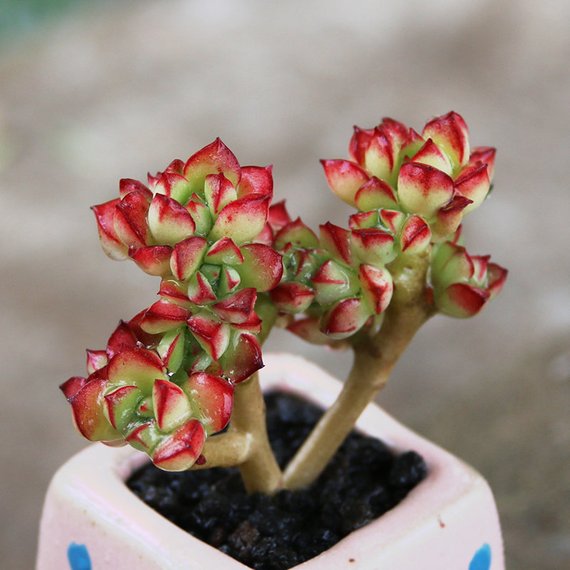Characteristics: It is an upright succulent shrub that can grow tall. The leaf rosettes are bowl-shaped, with ovate leaves that are smooth and green. The tips and edges of the leaves turn red, and there is a reddish line along the leaf margin. Under strong light, the tips and edges of the leaves also turn red.
Usage: Ornamental.
Distribution: Found in various regions including Asia, Africa, and South America.
Care:
Soil:
Echeveria supia prefers loose, well-draining soil. A mixture of peat, loam, and perlite in a ratio of 3:1:1 is suitable.
Adequate sunlight:
Echeveria supia prefers sunlight. During spring and autumn when the sunlight is not intense, it can be placed on the balcony to receive long hours of sunshine. In summer, when sunlight is intense, shading should be provided to prevent leaf scorching.
Suitable temperature:
The optimal temperature for Echeveria supia is between 20-29°C. During high summer temperatures, shading should be provided to prevent growth cessation. In winter, the temperature should be maintained above 2°C for safe wintering.
Moderate watering:
Echeveria supia is drought-tolerant and does not require frequent watering. During hot summers when growth is slow, water once every 10 days. When it is excessively dry, spraying water around can help cool down the surrounding area.
Echeveria supia belongs to the spring-autumn growth type and prefers a sunny, warm, and dry environment. Most of the time, the leaves are yellow-green, resembling jelly, and only in the autumn and winter seasons with sufficient sunlight and significant temperature differences, they exhibit the ultimate red coloration. Long periods of insufficient sunlight or excessive watering can lead to fading and elongation of the leaves, reducing their ornamental value. After Echeveria supia matures, it is not advisable to use too much granular soil or overwatering, as this can easily lead to the growth of aerial roots, which can also detract from its appearance.
Maintenance Tips:
Echeveria supia prefers ample sunlight and good ventilation. It requires loose, well-draining soil, and the pot should be breathable with drainage holes.
Echeveria supia prefers a relatively cool environment. It should be protected from high temperatures and humidity during the spring-summer transition. Prolonged exposure to rain during this period can easily cause sudden diseases such as smut, black rot, and leaf drop. After the summer, it should be placed in a cool and ventilated area and watering should be reduced.
Echeveria supia tends to branch. After maturity, it often grows into small shrubs. Proper pruning is necessary to maintain a good shape. During the vigorous growth period, some elongated and weak branches can be pruned appropriately to maintain a good plant shape.
Echeveria supia generally blooms from late spring to early summer, with orange-red bell-shaped flowers. Flower enthusiasts who appreciate the blooms can choose to retain them. After flowering, trim the spent flowers, and apply a small amount of water-soluble or slow-release fertilizer.
Echeveria supia can be propagated mainly by cuttings, including leaf cuttings and stem cuttings. Stem cuttings are simpler and faster for Echeveria supia, which tends to grow branches. Select semi-woody branches and side shoots, dry the wounds, and then insert them into loose, well-draining sandy soil for propagation. Roots generally develop within 2 weeks.
After Echeveria supia matures, due to the increasing woody degree of its branches, it is prone to the phenomenon of aerial roots in relatively humid spring and summer seasons. This is a normal phenomenon for mature plants. However, if leaf drop occurs along with aerial root growth, it is related to the health of the root system and the moisture content of the potting soil. It is advisable to remove the plant for inspection, trim the roots appropriately, and then repot it. For severely aged plants, propagation through cuttings can also be considered for rejuvenation.
